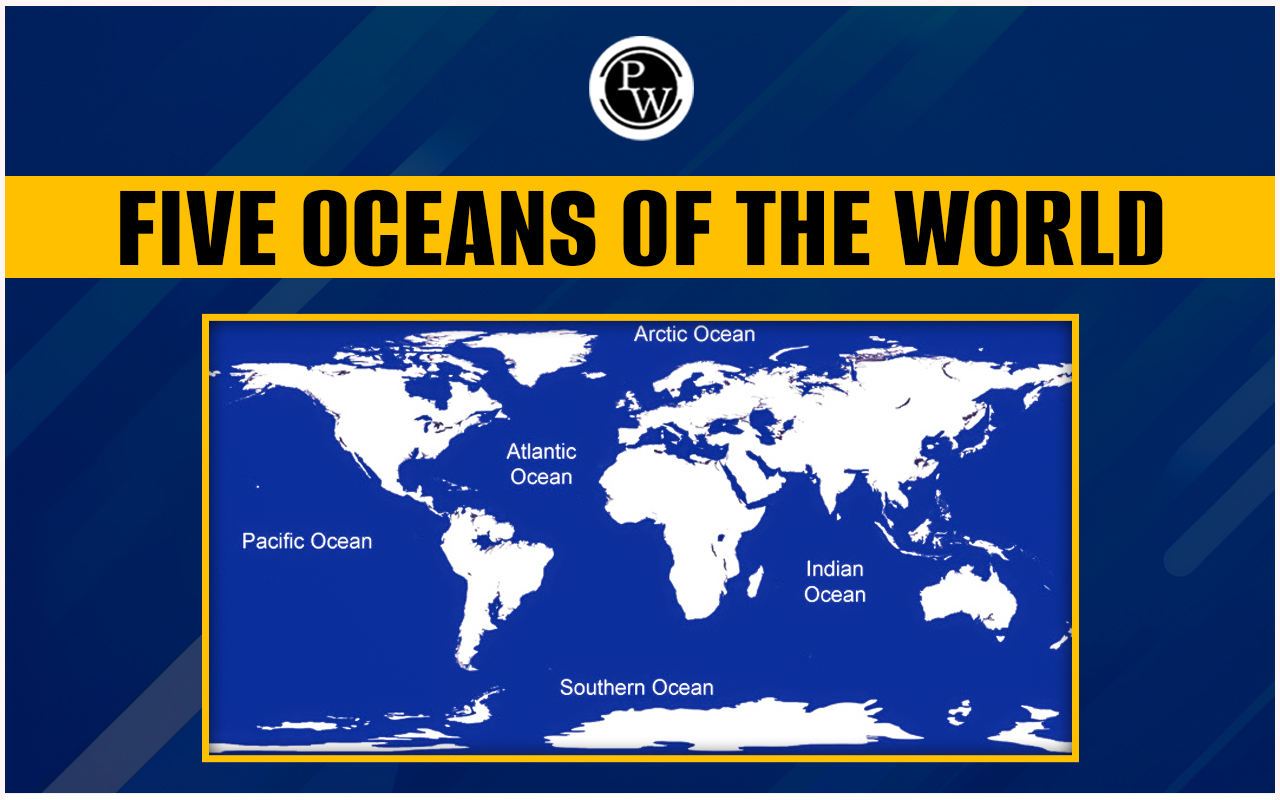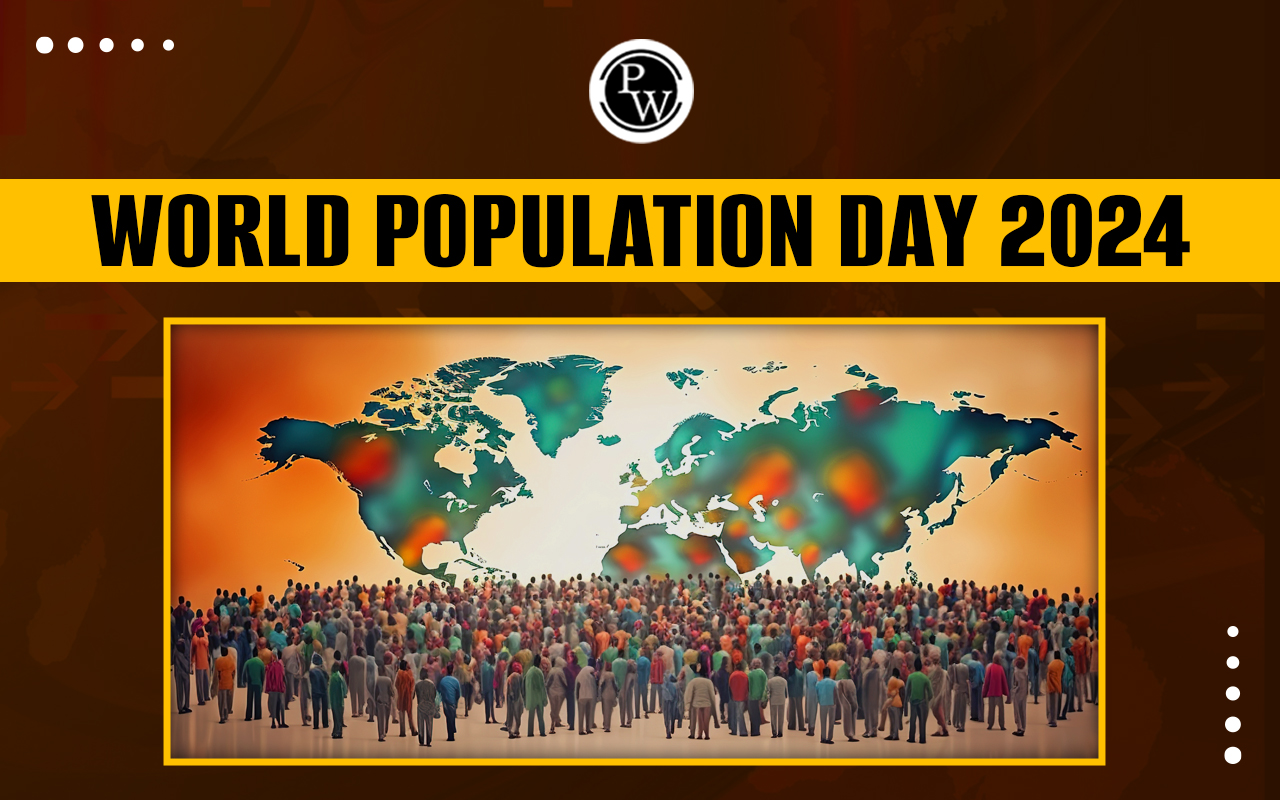

Five Oceans of the World: The Earth is known as the "Blue Planet" because about 71% of its surface is covered with water. This vast expanse of water is divided into five major oceans, each unique in its characteristics, marine life, and geographical significance. Understanding these oceans is important, not just for geographical knowledge, but also for appreciating the diversity of life they support and their impact on global weather patterns, trade routes, and ecosystems. In this article, we will explain the five oceans of the world in detail.
Five Oceans of the World: Name
The five oceans of the world are: Pacific Ocean, Atlantic Ocean, Indian Ocean, Southern Ocean, & Arctic Ocean. Each of these oceans is a unique body of water with distinct characteristics, playing a crucial role in the Earth's ecosystem and geography.Five Oceans of the World: Size
The size of these oceans varies significantly. The Pacific Ocean is the largest, covering over 168,723,000 square km, while the Arctic Ocean is the smallest, spanning about 15,558,000 square km. The Atlantic Ocean is the second-largest, followed by the Indian and Southern Oceans. The vast size of these oceans contributes to their impact on global climate, weather patterns, and marine life.Five Oceans of the World: Location
The location of each ocean is geographically distinct. The Pacific Ocean lies between Asia and the Americas, the Atlantic separates the Americas from Europe and Africa, the Indian Ocean is bordered by Africa, Asia, and Australia, the Southern Ocean encircles Antarctica, and the Arctic Ocean surrounds the North Pole, bordered by North America, Europe, and Asia. These locations define their climate, marine ecosystems, and influence on surrounding continents.Five Oceans of the World Details
Most important details of Five Oceans of the World are described below for candidates reference:The Pacific Ocean
The Pacific Ocean is the largest and deepest of all the oceans, covering more than 168,723,000 square km and reaching depths of over 36,000 feet (nearly 11,000 meters) in the Mariana Trench. It stretches from the Arctic in the north to the Southern Ocean in the south, and from Asia and Australia on the west to the Americas on the east.Significance: The Pacific Ocean plays a crucial role in the Earth's climate system. It is home to the "Ring of Fire," an area with many active volcanoes and frequent earthquakes. The ocean also hosts some of the world's most diverse marine life, including coral reefs like the Great Barrier Reef in Australia, and numerous islands and archipelagos that are rich in culture and history.
Marine Life: The Pacific is filled with life, from tiny plankton to the giant blue whale. It supports an enormous variety of fish, marine mammals, birds, and invertebrates. Coral reefs, like those found in the Pacific, are among the most biologically diverse ecosystems on Earth.
Interesting Fact: The Pacific Ocean is so vast that it contains almost half of the free water on Earth. If all the continents were to be placed inside the Pacific, there would still be room left over.
The Atlantic Ocean
The Atlantic Ocean is the second-largest ocean, covering about 85,133,000 square kilometers. Atlantic Ocean separates America from Europe and Africa. The Atlantic is known for its "S-shaped" curve and is divided into the North Atlantic and South Atlantic by the equator.Significance: Historically, the Atlantic Ocean has been a critical route for trade, exploration, and colonization. Today, it remains vital for international shipping and communication. The Gulf Stream, a powerful Atlantic Ocean current, significantly influences the climate of the east coast of North America and Western Europe.
Marine Life: The Atlantic Ocean supports various marine species, from commercially important fish like cod and haddock to marine mammals like dolphins and whales. The Sargasso Sea, located in the North Atlantic, is unique due to its free-floating seaweed and diverse marine life.
Interesting Fact: The Titanic, one of the most famous shipwrecks in history, sank in the North Atlantic Ocean in 1912. Its story continues to fascinate people around the world.
The Indian Ocean
The Indian Ocean is the third-largest ocean, covering about 70,560,000 square kilometers. It is bordered by Africa to the west, Asia to the north, Australia to the east, and the Southern Ocean to the south. The Indian Ocean is known for its warm temperatures, as it is mostly located in tropical and subtropical regions.Significance: The Indian Ocean is a vital maritime trade route, especially for oil and gas transport. It is also home to important choke points like the Strait of Hormuz and the Malacca Strait. The monsoon winds, which blow across the Indian Ocean, have a significant impact on the climate of surrounding regions, particularly in South Asia.
Marine Life: The Indian Ocean is rich in marine biodiversity, including a variety of fish, crustaceans, and coral reefs. It is also home to endangered species like the dugong (sea cow) and the Indian Ocean bottlenose dolphin. The warm waters of the Indian Ocean are ideal for coral reefs, which are found along the coasts of countries like Australia, Indonesia, and the Maldives.
Interesting Fact: The Indian Ocean is the only ocean named after a country, India. This reflects the historical importance of India's trade links with the rest of the world.
The Southern Ocean
The Southern Ocean, also known as the Antarctic Ocean, surrounds the continent of Antarctica and extends to 60 degrees south latitude. It is the fourth-largest ocean, covering about 21,960,000 square kilometers. It is the coldest ocean, with waters often covered by sea ice.Significance: The Southern Ocean plays a crucial role in regulating the Earth's climate. It is the only ocean that encircles the globe without being interrupted by land, which allows it to drive the global ocean circulation. The Antarctic Circumpolar Current, the world's largest ocean current, flows around Antarctica and connects the Atlantic, Pacific, and Indian Oceans.
Marine Life: Despite its harsh conditions, the Southern Ocean supports variety of marine life, particularly in its nutrient-rich waters. It is home to species like the Antarctic krill, which is a crucial part of the marine food chain, as well as penguins, seals, and whales. The Southern Ocean is also a critical habitat for many species of seabirds, including the albatross.
Interesting Fact: The Southern Ocean was only officially recognized as a distinct ocean by the International Hydrographic Organization in 2000, making it the youngest of the world's oceans in terms of recognition.
The Arctic Ocean
The Arctic Ocean is the smallest and shallowest of the five oceans, covering about 15,558,000 square kilometers. It is located around the North Pole, bordered by North America, Europe, and Asia. Much of the Arctic Ocean is covered by sea ice, which varies in extent depending on the season.Significance: The Arctic Ocean is crucial for regulating the global climate, particularly through its impact on sea ice, which reflects sunlight and helps to cool the planet. The region is also of great geopolitical interest due to its potential untapped natural resources, including oil and gas.
Marine Life: The Arctic Ocean, though cold and harsh, supports a diverse range of marine life, including polar bears, walruses, seals, and whales. The ocean's plankton-rich waters are a critical food source for many of these species. The Arctic's unique ecosystem is highly sensitive to climate change, which is causing sea ice to shrink and temperatures to rise.
Interesting Fact: The Arctic Ocean is the only ocean where polar bears are found naturally. These animals are top predators in the Arctic ecosystem, relying on sea ice to hunt seals.
Importance of Five Oceans of the World
The five oceans of the world, the Pacific, Atlantic, Indian, Southern, and Arctic are more than just vast bodies of water. They are critical to life on Earth, influencing weather patterns, supporting marine ecosystems, and providing resources for human civilization. By understanding the unique characteristics of each ocean, we gain a greater appreciation for their role in sustaining life and their importance in the global environment. As we face challenges like climate change, pollution, and overfishing, it is more important than ever to protect and preserve our oceans. They are not just part of our natural heritage but are vital to the future of our planet. Whether it's the depths of the Pacific, the warmth of the Indian, the cold expanse of the Southern, or the icy waters of the Arctic, each ocean continue to inspire awe and demand our attention.Five Oceans of the World FAQs
Which is the largest ocean?
Which ocean surrounds Antarctica?
What is the smallest ocean?
Where is the Atlantic Ocean located?












